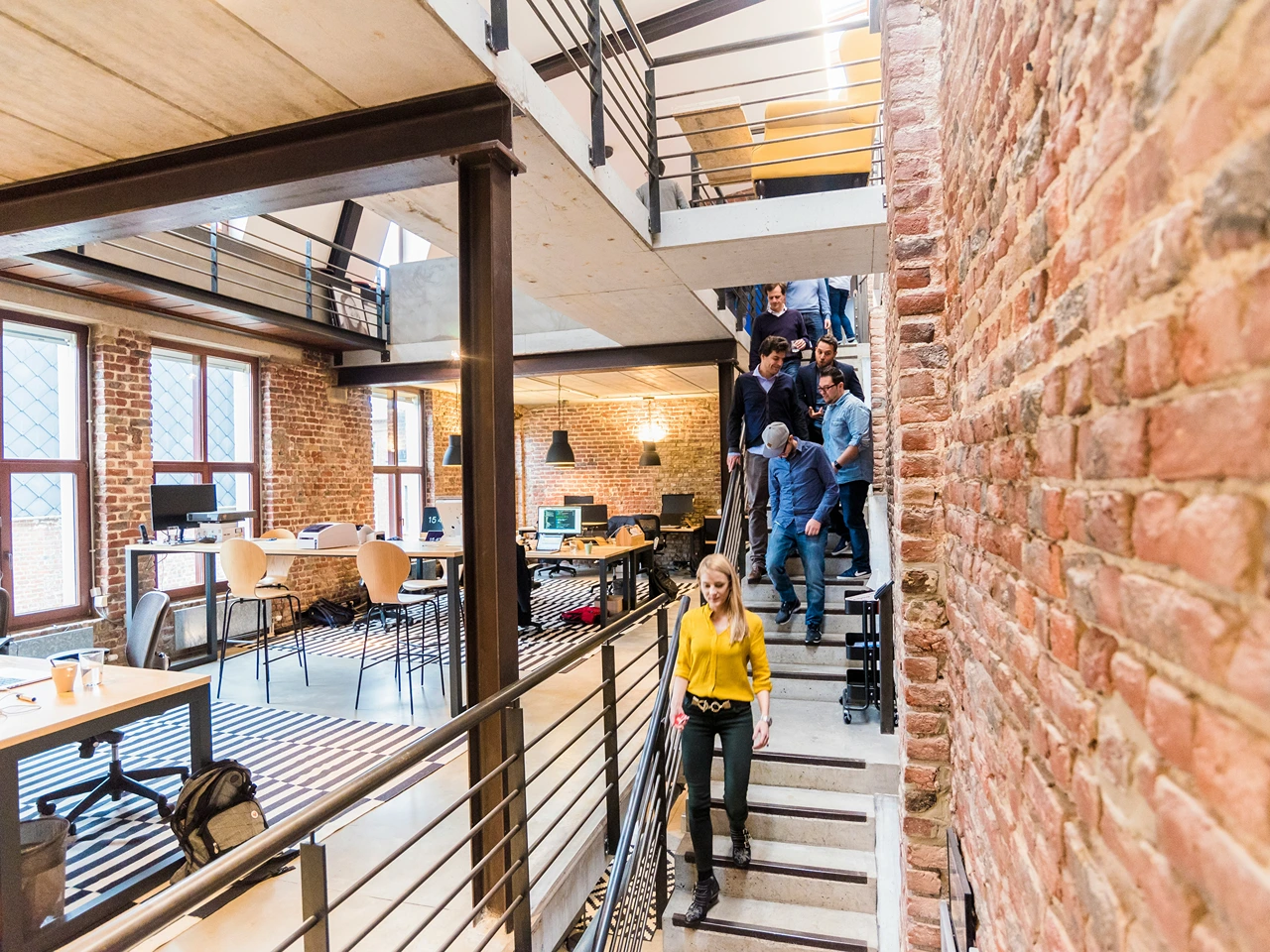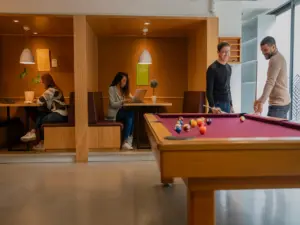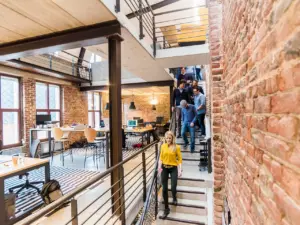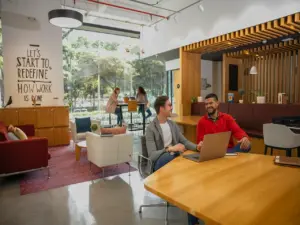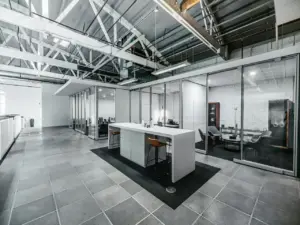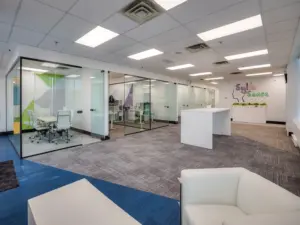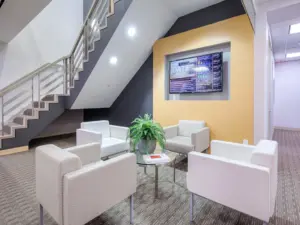A well-designed workplace does more than provide a space to work—it fosters productivity, innovation, and employee satisfaction. For large corporations occupying over 40,000 square feet, the challenge isn’t just about accommodating employees but about crafting a modern office design that enhances connectivity, efficiency, and corporate culture. The key is to design workspaces that balance collaboration with focused work, integrate intuitive technology, and reflect the company’s values.
This article explores the challenges and opportunities in modern office design, offering insights into how companies can create high-performing workplaces that evolve with their needs.
The Challenges and Opportunities of Large-Scale Modern Office Design
Designing workspaces for large teams presents unique hurdles. While smaller offices can naturally foster collaboration, larger work environments require intentional planning to prevent silos and maintain engagement. The goal is to create a space that supports both individual focus and seamless team interaction.
A well-designed modern office design encourages movement, social interaction, and efficiency. It optimizes space without feeling overwhelming and ensures employees feel connected to the company’s mission, even if they’re working across multiple floors. This balance between scale and cohesion defines a truly high-performing workplace.
Challenge: Maintaining Collaboration and Company Culture in Modern Office Design
A common issue in large offices is the loss of spontaneous communication and collaboration. Employees who work on different floors or in separate departments may rarely interact, leading to a fragmented company culture. Hybrid work models further complicate this, as uneven attendance can create office environments that feel either overcrowded or deserted.
As renowned researcher Thomas Allen observed, “We are four times as likely to communicate regularly with someone sitting six feet away from us as with someone 60 feet away.” Without intentional modern office design solutions, physical separation can lead to decreased knowledge sharing and weaker relationships within teams.
Solution: Vertical Integration and Communal Areas in Modern Office Design
To counteract these challenges, modern office design must encourage movement and interaction between floors. One solution is the strategic placement of an internal staircase, which serves as both a functional connection and a visual cue that fosters engagement between departments.
Common areas, such as break rooms, lounges, and shared workspaces, should be positioned thoughtfully across multiple levels to attract employees from different teams. A centrally located lunchroom equipped with unique amenities can become a hub for social interaction, encouraging employees to engage with colleagues they may not otherwise encounter.
Another effective tool in modern office design is desk-booking technology. Employees can see where their colleagues are seated on any given day, allowing for more strategic in-office collaboration. This approach helps balance office occupancy and ensures that workspaces remain lively and connected.
Challenge: Creating a Flexible and Future-Proof Modern Office Design
Large corporations must be prepared for change. Market shifts, company growth, and new ways of working all demand adaptable office spaces. A rigid design that works today may become inefficient in just a few years, leading to expensive overhauls or underutilized areas.
Workplace strategies that embrace modular planning and adaptability allow companies to evolve without major disruptions. Modern office design should be built with longevity in mind, using flexible solutions that can accommodate future needs.
Solution: Modular Design and Multi-Purpose Spaces in Modern Office Design
Modular workspaces provide businesses with the ability to adjust layouts quickly and efficiently. Moveable walls, flexible furniture, and multi-use rooms allow for seamless transitions between different work styles. Whether the company expands or shifts to a more hybrid workforce, these adaptable solutions ensure that the office remains functional and relevant.
Open work areas can be supplemented with smaller, private pods that offer a quiet retreat for focused work. Large conference rooms can be designed with partition systems to create smaller meeting spaces when needed. By thinking ahead and incorporating modular modern office design, companies can avoid costly renovations while keeping their workspace dynamic and engaging.
Challenge: Balancing Privacy and Openness in Modern Office Design
An open office layout can promote collaboration, but it can also lead to distractions and a lack of privacy. Employees need spaces that allow them to work without interruption, while still maintaining a sense of connectivity within the office. Finding the right balance is key to creating a productive and enjoyable environment.
Solution: Zoning and Acoustic Considerations in Workplaces
A high-performing workplace includes different zones tailored to various work styles. Collaborative areas should be positioned away from quiet focus zones, ensuring employees have options depending on their tasks. Soundproof booths, private offices, and designated quiet areas help reduce noise and provide spaces for concentration.
Acoustic design also plays a crucial role in modern office design. Incorporating sound-absorbing materials such as carpets, ceiling panels, and dividers can minimize distractions, improving both focus and communication. Thoughtful layout planning ensures that employees don’t feel isolated while still having access to quieter spaces when needed.
Challenge: Enhancing Employee Well-Being and Comfort
A workplace should prioritize not just efficiency but also employee well-being. Poor lighting, uncomfortable furniture, and uninspiring environments can negatively impact mood, engagement, and overall health. Large corporations must design their offices with human needs in mind, ensuring comfort and inspiration are at the forefront.
Solution: Biophilic Modern Office Design and Ergonomic Workspaces
Incorporating nature into the office—known as biophilic design—has been proven to enhance well-being and productivity. Greenery, natural materials, and ample daylight help reduce stress and increase job satisfaction. Modern office design can integrate indoor gardens, living walls, or simple potted plants to create a more inviting atmosphere.
Ergonomics is another key factor in employee comfort. Height-adjustable desks, supportive chairs, and flexible workstations help reduce strain and promote better posture. Employees should have the ability to customize their workspace to fit their needs, creating an environment that supports long-term health and performance.
Challenge: Navigating a Multi-Floor Modern Office Design
In a large corporate office, navigation can become an issue. Employees may struggle to find meeting rooms, locate colleagues, or even feel disconnected from other departments. A poorly organized layout can lead to wasted time and frustration, affecting both morale and efficiency.
Solution: Thoughtful Wayfinding and Smart Technology
Clear signage, intuitive floor layouts, and digital wayfinding systems can significantly improve navigation. Smart office technology—such as apps that provide real-time desk availability, meeting room booking, and colleague location—can streamline the employee experience, making modern office design more intuitive to navigate.
Additionally, incorporating visual cues like color-coded areas or distinct design elements for different sections of the office can help employees orient themselves more easily. A well-planned workspace ensures that movement is effortless, reducing stress and boosting overall efficiency.
Key Takeaways
- Modern office design plays a crucial role in fostering productivity, collaboration, and employee well-being in large corporations.
- Balancing collaboration and privacy is essential—zoning, acoustic considerations, and flexible layouts help create an optimal workspace.
- Modular design and adaptability ensure offices can evolve with business needs, reducing the risk of costly renovations.
- Employee well-being is enhanced through biophilic design, ergonomic workspaces, and comfortable, inspiring environments.
- Smart technology and wayfinding solutions improve navigation, connectivity, and efficiency in multi-floor office layouts.
- A future-proof office prioritizes flexibility, human-centered design, and strategic planning to support long-term business success.
Final Thoughts: The Future of Modern Office Design
Designing an office for a large corporation goes beyond simply providing desks and meeting rooms. It’s about creating an environment that fosters collaboration, flexibility, well-being, and efficiency. By embracing modular planning, biophilic design, intuitive technology, and thoughtful zoning, companies can build workspaces that support their employees and drive long-term success.
The future of modern office design is all about adaptability. As workplaces continue to evolve, businesses that prioritize strategic, human-centered environments will have the advantage—retaining top talent, boosting productivity, and fostering a culture of innovation. High-performing workplaces don’t just happen; they are designed with intention, ensuring that every square foot contributes to a thriving and dynamic work environment.
Frequently Asked Questions (FAQ):
What are the strategies for enhancing productivity in high-scale companies?
Incorporate biophilic design, intuitive technology, and thoughtful zoning to your workspace design. These are crucial for these strategies can support their employees’ well-being and drive long-term success.
Any tips for navigating multi-floor modern office design?
Clear signage, intuitive floor layouts, and digital wayfinding systems can significantly improve navigation. Also, apps that provide real-time desk availability, meeting room booking, and colleague location can streamline the employee experience, making modern office design more intuitive to navigate.
How is loss of collaboration mitigated in a multi-floor office design?
Place common areas, such as break rooms, lounges, and shared workspaces across multiple levels to attract employees from different teams. These encourage employees to engage with colleagues they may not otherwise encounter.
